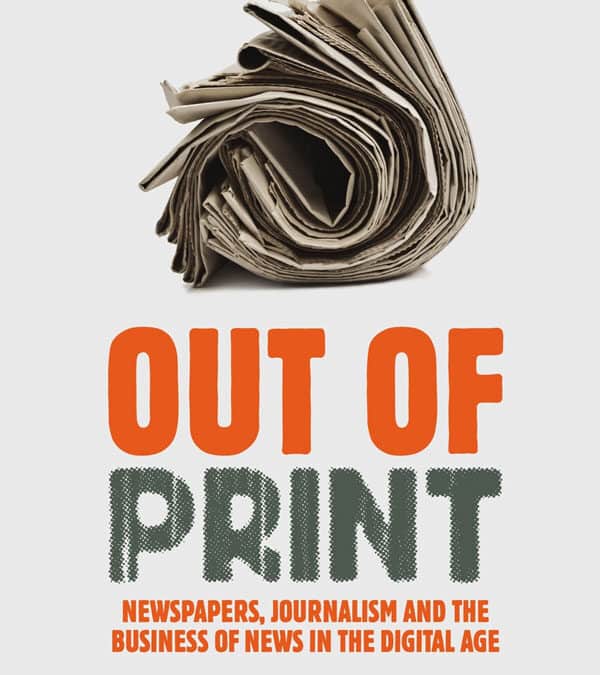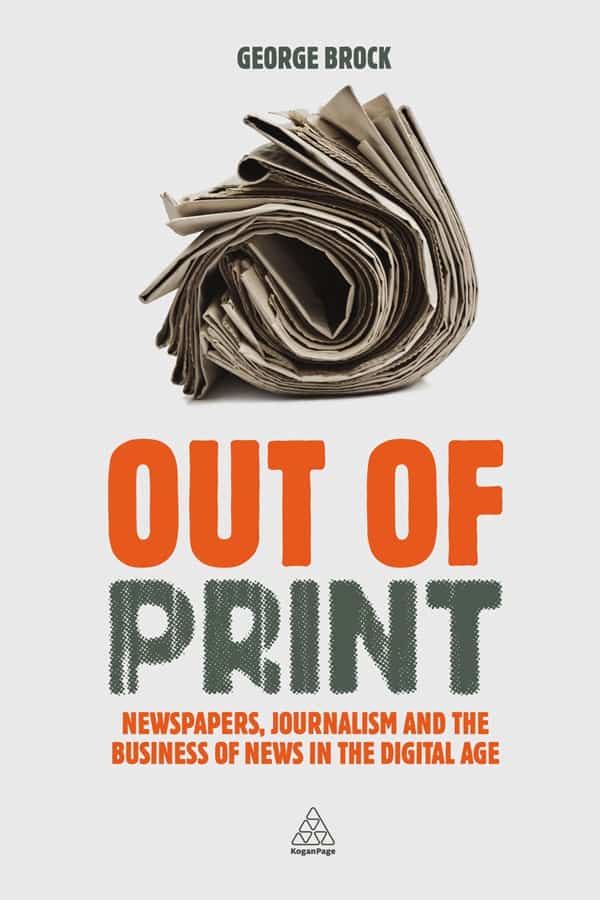Out of Print, Newspapers, Journalism and the Business of News in the Digital Age by George Brock
Recommendation
Can journalism thrive in the digital era? The answer, British media scholar George Brock suggests, lies not with one business model but with many – including paywalls, sponsorships and philanthropy. Legacy media organizations can learn from online start-ups, which nimbly experiment with formats and funding models. Innovation fueled journalism from its beginnings, as Brock demonstrates in a comprehensive look at the history of the news. Brock, who writes from an English perspective, devotes two of his 10 chapters to how the British phone-hacking scandals damaged media credibility. He issues a stern warning to media executives: Organizations that fail to innovate will not be part of journalism’s future. getAbstract recommends his historical overview to those in and out the news business who believe that a free society prospers when journalism does.
Take-Aways
- Journalism always had to adjust and change. In the digital age, it must change again.
- Impartiality, human interest and timeliness all emerged from journalism’s adaptations.
- Journalism’s long period of stability in the mid-20th century was illusory and disappeared as time-starved readers changed their habits.
- Media companies that tried to achieve profitability by cutting costs should have innovated instead.
- Britain’s inquiry into the phone-hacking scandals missed a chance to bolster the media’s credibility by clarifying a legal defense based on the “public interest.”
- BuzzFeed is right: For experiments in online journalism, “error is useful.”
- Successful online ventures have discernable value and diverse income streams.
- Journalism’s future rests not with one business model but with many, including paywalls, sponsorships and philanthropy.
- Paywalls can work when the content has distinct value and is hard to replicate.
- Journalism must focus on four fundamental tasks: “verification,” “sense-making,” “witness” and “investigation.”
Out of Print Book Summary
Centuries of Experiments
How will journalism deliver the news in the digital age? Who will pay for it? How will the definition of “journalist” change and, for that matter, the definition of “news”?
Many mainstream news organizations won’t survive today’s digital transition, but journalism itself will endure. In Europe and America, journalists are experimenting with new business models, new formats and new technologies. As some succeed and some fail, experimentation is shaping journalism’s future just as it shaped the industry’s past.
“While I am pessimistic about the survival chances of some threatened daily newspapers, I am an optimist about journalism. There is a role for journalism even if some of its present institutions struggle to breathe.”
Most of journalism’s conventions – such as usefulness, independence, impartiality and timeliness – grew from centuries of experimentation. In the 1500s, printers discovered that distributing packages of news and advertising boosted their cash flow. Stories about which ships had docked at various ports and with what cargo were particularly valuable. Today’s media watchers would call that information “market-moving” news.
“Change is the only constant in journalism’s history.”
In England, the spread of Protestantism in the late 1600s encouraged literacy and fueled ideas about individual autonomy and the right to form individual political opinions. Newspapers began to stress eyewitness accounts and to tout their independence from party and faction. England experienced its revolution and counterrevolution earlier than other societies, setting the stage for a sustained period of stability and “a relatively confident national press.”
“If information flows like liquid in and out of devices 24 hours a day, journalism’s value lies in something it has done before: sifting, distilling, taking the signal from the noise.”
In America, the press developed as a conduit for ideas that unified the diffuse population and spread public opposition to colonial rule. “News was political glue.” When America adopted its Constitution, the First Amendment enshrined protection for the press. This was the first time any country adopted a law guaranteeing freedom of publication.
“The future of journalism will be made by a combination of existing organizations that adapt and new entrants who can supply a demand better than legacy news media.”
Then as now, technology opened the door to innovation. The telegraph sped the gathering of news, and the papers that embraced it gained an edge. Before the Franco-Prussian War, journalists sent only some dispatches by telegraph and longer narratives by mail. During the war, the Daily News directed its correspondents to file all their dispatches by telegraph. Sales tripled.
“Over the long term, the price of most goods tends to fall. The cost of good journalism is an exception to this rule.”
The telegraph and the trans-Atlantic cable fueled the growth of news agencies such as Reuters and the Associated Press. Those services upset news as a “commodity” to many clients over long distances and required reporters to adopt a neutral viewpoint, marking the arrival of impartiality.
Disruptions
Print journalism appeared to enjoy a sustained period of relative stability through the second half of the 20th century. That stability proved illusory. Mass audiences fragmented with the emergence of new sources of information. Readership habits changed: People worked longer hours, and women entered the workforce in great numbers, leaving them less time for reading.
“The temporary surge in newspaper profitability in the 1990s was mostly the result of a two-thirds fall in the price of paper.”
At century’s end, the Internet accelerated this disruption. The email list that Craig Newmark began in 1995 in San Francisco exploded into Craigslist, offering searchable job and property listings. By 2004, Craigslist took away at least $50 million in annual advertising revenue from San Francisco-area newspapers alone. Classified ad revenue, which was newspapers’ mainstay nationwide, plummeted. All types of print advertising have since declined. Newspaper companies’ digital revenue grows far too slowly to replace it.
“Wholesaling news as a commodity to many different outlets meant strict guidelines and rules keeping reporters to a neutral viewpoint.”
The Internet’s ability to make in-depth, useful information available on demand decreased people’s reliance on print media. “The reader’s loyalty weakens as the awareness grows that the newspaper is no longer the best or only provider of what they need.”
Most news organizations were ill-prepared for epic changes and challenges. Starting in the 1980s, when advertising revenues grew more volatile, news executives cut budgets to maintain profits. Their organizations grew more conservative in structure and processes. They failed to invest in technology or innovation when it might have made a difference.
Crisis of Credibility
Surveys show new low levels of trust in journalists and their work. Young people in particular find bias in media sources. In Britain from 2006 to 2011, belief in media bias grew among those between 18 and 34. A survey of Americans in the same age group showed that respondents rated newspapers lower in trustworthiness than cable or network TV, local TV news, or the Internet.
“Readership declined from the 1960s, circulation from the 1980s; profits did not fall until the 1990s.”
In the early years of the 21st century, forces aligned in Britain to create a media credibility crisis of historic proportions. Editors in the popular press lost sight of the idea of testing the veracity of a story’s premise. Instead, they frequently told their reporters to “make this story work.” At the same time, news about celebrities was becoming a commodity, with brokers emerging to negotiate between newspapers and individuals who had information to sell. Invasions of privacy such as phone hacking became the norm. One news executive said: “When you have your editor shouting at you to get a story, you lose your morality.”
“It makes no more sense to say that ‘information wants to be free’ than it does to say that ‘information wants to be expensive’.”
Phone hacking reached public consciousness in 2006 when the courts convicted News of the World correspondent Clive Goodman and private detective Glen Mulcaire of hacking voice mail messages. News International, owner of the News of the World, entered into expensive settlements with complainants who suspected their phones had been hacked.
“Early newspapers, just as much as their successors, were platforms on which different designs were projected. Each one was an empirical experiment.”
A more damaging disclosure emerged in the summer of 2011: Two Guardian reporters revealed that Mulcaire, acting on behalf of News of the World, had hacked a phone owned by Milly Dowler, a 13-year-old girl who disappeared in 2002 and was later found dead. News of the World abruptly closed, and a massive investigation began. Police eventually identified 6,349 potential hacking victims.
“Journalism cannot survive without adapting again. The determinants of success or failure are the quantity and quality of experiment.”
Lord Leveson, who chaired the inquiry, recommended a system of regulations that would provide redress for complaints, promote standards and impose sanctions. He proposed amending the civil laws allowing courts to impose damages on media organizations that did not endorse regulatory rules. His proposal for legislation to put those incentives into effect met with skepticism. A subsequent closed-door compromise over a “Royal Charter” to set up the system caused the debate to devolve into technicalities, and did not end up settling the issue.
“The fact that journalism has changed and will change further is not the same as its ruin.”
Leveson missed an opportunity to clarifying the “public interest” defense for use in privacy cases. A definition of public interest would need to pass three tests: 1) Explain how the interests of the “collective entity” stretches beyond those of a “single individual”; 2) Explain the “prevention of harm”; and 3) Make a presumption in favor of “disclosure and free flow of information.”
Taking Stock of the Experiments
The future of digital journalism cannot depend on any one business model. News organizations must try combination solutions that vary by market and by culture. Experimental start-ups, whether they are focused on niche audiences or are offering hyperlocal content, will bring entrepreneurial energy to journalism. Not all experiments will succeed. As a slogan at the website BuzzFeed says, “Error is useful.” Experiments that are underway today include:
- “Paywalls” – Asking people to pay for content only functions when the “content’s value is clear and is hard to replicate.” Sports statistics sites successfully charge for access because their users find high value in their data. Conversely, The Daily – the iPad news magazine backed by News Corporation and Apple – failed using this strategy because too few readers found it valuable; its audience proved insufficient to support its business model. “Engagement” is a common measure of how much value users perceive in a website; engagement measures how long people stay on the site and how often they share its content with others.
- “Page views” – Engagement may be less of a concern for sites with bigger audiences because “the larger the total audience, the bigger the ‘core’ of users who may notice what’s on the site.” Most visitors to big sites are casual users. Do they pay more or less attention to ads than regular users?
- “Philanthropy” – Some tout this as a new way to support journalism, but its applicability may be limited to specialized endeavors and it may work only in societies with plenty of donors. In the United States, the John L. and James S. Knight Foundation funds innovative journalism; the Sandler family funds ProPublica, an investigative site. Media analyst Alan Mutter calculated that keeping the US news business going would require an endowment of at least $88 billion – nearly one-third of the total that Americans give to charity every year.
- “Free newspapers” – Distributing free papers and relying on advertising works in some settings, such as with mass-transit riders in major cities. London supports Metro in the morning and The Evening Standard in the afternoon. Both depend on holding distribution rights on the city’s rail networks.
- “Sponsorship” – Quartz, the business-journalism arm of The Atlantic, launched in 2012 with four major sponsors: Chevron, Boeing, Credit Suisse and Cadillac. It offered “native advertising” to smaller advertisers who can generate sponsored articles. Will readers find the site’s journalism credible despite the sponsors’ presence?
- “Public subsidy” – Many countries grant subsidies to news organizations. These seem unlikely to grow, given the fiscal realities of most governments in the developed world.
- “Revenue promiscuity” – The Texas Tribune and the Korean site OhmyNews, for example, turned to moneymaking events such as marathons and conferences.
- Indirect support from governments – A growing campaign in Britain urges the government to make it easier for fledgling news organizations to raise money to support their operations.
“Journalists and publishers can talk freely about the future, change and what needs to be done, yet as soon as they return to their busy desks in the newsroom, the ideas evaporate.”
News organizations prospering online share the following characteristics: a clear promise of value, a lean organization that grows cautiously, diverse revenue streams and a “niche target audience.”
Journalism’s Future
Newspapers, for all their need to cut costs and all their profit pressures, remain “very reluctant to die.” Printed newspapers are likely to become a less-important part of the media mix in many societies, but it’s unlikely they will vanish. Change will come gradually. Readers of news, particularly those older than 40, are creatures of habit. Even if they switch to electronic tablets to read their newspapers, they will adapt most readily to apps that mimic print layouts.
As digital journalism grows, some conventions of 20th-century print will recede. Fairness and accuracy will remain paramount, but the individual writer’s voice – whether through analysis, opinion or commentary – will increase in importance. With so many sources available, any journalist who can illuminate a story’s importance will have an advantage.
If anyone with a smartphone or a blog can take on the title “journalist,” do professional journalists offer distinct value? They do now, and will continue to do so in the future if they focus on four fundamental tasks that people trained as journalists perform:
- “Verification” – Finding out what really happened, especially if facts are in dispute.
- “Sense-making” – Very few facts are “pure” and not subject to interpretation or context. “There never was a golden age when newspapers ‘of record’ just stuck to the facts.” Journalists strive to provide meaning to the facts they report.
- “Witness” – Some situations demand “an experienced eyewitness.”
- “Investigation” – Ferreting out hidden information requires skill and experience.
People who aren’t journalists may do some of these things, and news media contain plenty of material that doesn’t fall into any of these categories. Still, these four tasks form the essence of journalism. The trust invested in journalism rests on them. They are the foundation of whatever journalism becomes in the century ahead.
About the Author
George Brock heads the Graduate School of Journalism at City University London. A former reporter and editor at the Observer and The Times, he serves on the board of the International Press Institute.



